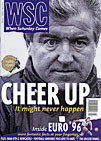 Everyone's got an opinion about how England should play in Euro '96. Not wanting to feel left out, we've chipped in too
Everyone's got an opinion about how England should play in Euro '96. Not wanting to feel left out, we've chipped in too
A dilemma for all English managers but particularly for Terry Venables, as he’s the only one at work over the next few weeks. Should they heed the advice of those who believe that England can only succeed by playing to their strengths – running and gung ho spirit and lots of headers – or should they be encouraging their teams to play a more patient passing game, with defenders carrying the ball from one area to the other, and then back again if the mood takes them?
Frankly, we don’t know. And neither does anyone else. But, given that no-one is likely to ask us what we think Terry should do, we decided to put it down on paper on the off chance that he wakes up in a sweat in the middle of the night and decides to seek for guidance by leafing through the press clippings that (one assumes) are painstakingly prepared for him by Don Howe.
The present England squad looks strong on forward players (albeit players unaccustomed to the man-for-man marking likely to be employed by international opponents) but much weaker in defence, particularly in the centre. In an ideal world every England team would feature defenders who are actively interested in getting the ball, controlling it and giving to someone else on their side, rather than hoofing it away when it comes near them.
Sadly, the current England manager doesn’t have the option of selecting such players. So, on the basis that you need to step backwards before you can go forward, Terry Venables could do worse than copy the formation that produced arguably England’s best ever performance against strong continental opposition, the 4-0 win in Italy in 1948.
In those days English teams played with two full backs (chunky and fast); one stopper centre half (tough and slow, still in plentiful supply today); two wing halves (one fastish and stroppy, with a fondness for crunching tackles, the other slower and capable of passing the ball accurately over long distances), and five forwards. For the Italy match in 1948 these five were wingers Stanley Matthews and Tom Finney, inside forwards Stan Mortensen and Wilf Mannion, and centre forward Tommy Lawton (with hair liberally brilliantined to facilitate glancing headers).
Let’s imagine Les Ferdinand as Tommy Lawton, Paul Gascoigne and Robbie Fowler as Mannion and Mortensen (Robbie’s demob hairstyle suits the period, weight wise Gascoigne would the equal to Stan and Wilf combined), Steve McManaman and Steve Stone as Stan and Tom. Paul Ince and Jamie Redknapp would be the nasty and nice wing half combination, Gary Neville and Stuart Pearce the full backs (Gary’s a bit thin, Stuart ultra beefy, together they balance out), with somebody statuesque and muscular at centre half (Steve Howey, Sol Campbell, Lennox Lewis, it really doesn’t matter much).
Oh, and the goalkeeper in 1948 would have worn a thick roll neck jersey, the sort old relatives buy you for Christmas when you’re 10. A bit itchy for the summer, but still a darn sight more acceptable than the psychedelic monstrosities keepers are forced to wear today. Bottle green, then, for David Seaman, navy blue for Ian Walker, something in slate grey with a crucifix motif for Tim Flowers because he’ll need all the help he can get.
This team may not win the European Championships, but we’d prepare to bet that they could see off the 1948 Italian side, assuming they’re all still with us and up for a kickabout. Small steps and all that.
From WSC 113 July 1996. What was happening this month